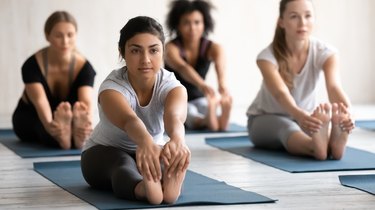
Tendonitis of the knee results in stiff, inflamed knee tendons that may also be painful. You can't stretch tendons, but you can help reduce the inflammation that contributes to tightness. You can also stretch tight knee muscles and do other exercises to relieve stiffness and improve mobility.
Reducing Knee Tendon Inflammation
Video of the Day
Tendons are thick bands of connective tissue that connect muscles to bones. They have a high concentration of strong collagen fibers which, according to Informed Health, makes them resistant to tearing, but not stretchy. In fact, according to the Massachusetts Institute of Technology, tendons shouldn't stretch at all.
Video of the Day
Therefore, stretching exercises won't elongate the tendons to relieve stiffness. Stiffness due to tendonitis, a condition typically caused by overuse according to Columbia University, is due to inflammation. Reducing inflammation can relieve tight tendons behind the knee and in front of the knee.
There are several ways to treat inflammation that can be carried out at home. According to the Cleveland Clinic, these include rest, ice and over-the-counter anti-inflammatory medications. You should also avoid the motion that is contributing to your tendonitis. If you are a runner, for example, it's time to take a break, or cross-train with cycling or swimming.
Read more: The 6 Best Stretches for the Back of the Knee, According to a Physical Therapist
Stretches for Tight Knee Muscles
Tight tendons in your knees may be caused by or worsened by tight knee muscles that attach to those tendons, explains UC San Diego Health. For example, tight hamstrings can cause tight tendons behind the knee, and tight quadriceps can cause tight tendons in front of the knee. While you can't stretch tendons, you can stretch muscles. Target the hamstrings, quads and calves with these stretches, recommended by the Cleveland Clinic.
Move 1: Hamstring Stretch
- Lie on your back and bend both your knees.
- Raise one leg and grasp it with both hands behind your thigh.
- Keeping your knee straight or slightly bent, pull the thigh towards you until you feel a stretch.
- Hold for 15 to 30 seconds.
- Release and switch sides.
Move 2: Quadriceps Stretch
- Stand on one leg. Hold on to a chair or wall for help with balance, if necessary.
- Bend your other knee and grab the front of your foot or ankle.
- Keeping both knees in line, pull your heel towards your glute until you feel a stretch along the front of your thigh.
- Hold for 15 to 30 seconds.
- Release and switch sides.
Move 3: Calf Stretch
- Extend one leg back and stand with both feet flat on the floor.
- Bend your front knee and keep your back leg straight and your foot pointing forward. You should feel a stretch along the back of your lower leg. Hold for 15 to 30 seconds.
- Next, bend your back leg, keeping the weight on your front foot. You should feel the stretch lower down your calf muscle. Hold for 15 to 30 seconds.
- Switch sides and repeat.
Read more: 9 Post-Workout Stretches You Need ASAP
Knee Mobility Exercises
Flexibility is the ability of a muscle to stretch, and mobility is the ability of a joint to move through its full range of motion, explains PennState Kinesiology. When you have tight knees, your range of motion is limited.
ALS Worldwide recommends this exercise for increasing mobility. It is an assisted passive exercise, in which another person manipulates the leg; however, you can do it yourself using a towel or yoga strap.
Move 1: Assisted Knee Flexion
- Lie on your back with your legs extended.
- Bend one knee and wrap a towel or strap around the middle of your foot.
- Hold one end of the strap with each hand, with your knee and hip at 90-degree angles.
- Extend your leg all the way out, allowing your arms and the strap to extend. Pull the strap in toward you so the knee bends and comes past 90 degrees.
- Pull the knee in toward the chest as far as you can, then extend the leg again.
- Repeat 10 to 20 times.
- Informed Health: "What Are Tendons and Tendon Sheaths?"
- Massachusetts Institute of Technology: "Flexibility"
- Columbia University: "Knee Pain and Problems"
- Cleveland Clinic: "Tendonitis or Bursitis? Your Best Treatments Begin at Home"
- UC San Diego Health: "Hamstring Tendonitis or Strain"
- Cleveland Clinic: "USTA Stretch"
- PennState Kinesiology: "The Importance of Flexibility and Mobility"
- ALS Worldwide: "Range of Motion Exercises"
Is this an emergency? If you are experiencing serious medical symptoms, please see the National Library of Medicine’s list of signs you need emergency medical attention or call 911.